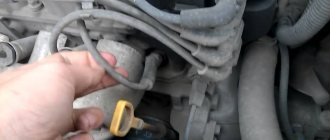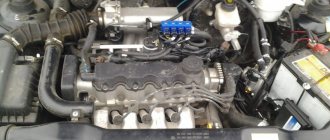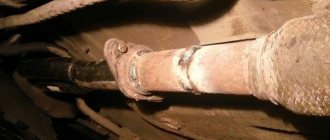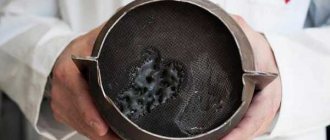A modern internal combustion engine is a system of many parts and mechanisms, the operation of which requires complex adjustments and settings. It is not surprising that a deviation in one direction or another can throw the installation out of balance and fundamentally affect its performance and technical condition.
One of the most common problems that requires an integrated approach to solve is potassium ignition. The average user observes it when the engine is turned off, when it continues to work for some time, being disconnected from the ignition. This problem is fraught with serious damage later and requires an early solution. In order to understand why this happens, it is necessary to understand its essence, which is what we will try to do.
Character of potassium ignition
In theory, there are two types of potassium ignition, and to better understand the causes and consequences of the problem, it is necessary to consider both options. One of them is specifically used in the power plant to ignite the air-fuel mixture, the appearance of the second is characterized by a malfunction of the engine, so it is considered dangerous. To protect the unit, it is necessary to correctly identify the first signs of the onset of a harmful phenomenon.
In modern power plants, spark ignition of the air-fuel mixture is almost universally used. Periodically, combustion is accompanied by the appearance of detonation and many confuse this process with potassium ignition, although these are completely different phenomena.
The detonation process is the explosive combustion of the air-fuel mixture, which is necessarily accompanied by a shock wave. Whereas potassium ignition is a normal combustion of a charge, characterized by early ignition.
Potassium ignition and the detonation process are interrelated. The increased thermal load on the parts of the power plant is a consequence of the occurrence of detonation. Which in turn leads to potassium ignition, characterized by early ignition of the fuel, low power and overheating of the engine. Potassium ignition is also dangerous because the engine does not stall after the ignition is turned off, as a result, the unit can go into overdrive and completely fail.
The engine does not turn off after turning off the ignition
Good afternoon Recently, this kind of garbage started happening - the engine periodically does not stall after turning off the ignition. car 2114 06. what could be the problem and how to fix it?
You should not be with someone you can be with, but with someone you cannot be without.
Rather, there is a turbo timer on the signaling system. Read the instructions.
+1 Most likely it’s in turbine mode. It will work for a couple of minutes and turn itself off.
Not Sherkhan 5 by any chance? Otherwise he lives his own life for me)
I agree, the lock is unlikely, it usually has other symptoms when it breaks
Last edited by support; 11/15/2011 at 10:53 am.
I know how to shut down the engine with a guarantee - put in third and drop the clutch. If it doesn’t drown out, then it’s a total disaster.
Do you have to run after her?)))
Do the dimensions light up? There was the same story on 14, I changed the on key. dimensions, everything went well.
She is alive.
+1 Most often this is the case - last year there was a similar story at Shnivy.
Last edited by support; 11/15/2011 at 10:54 am. Reason: Tag
it’s not one or the other, I was 14, the same thing happened, very rarely indeed. The alarm system was ancient and cheap. I didn't bother wrapping up
This happened, but rarely. At the same time, the revolutions floated smoothly or, on the contrary, jerked like a tractor. I read it on the Internet. After reading this, I changed the size button (so far everything is fine) ***I’M NOT JOKING, it really helped. There's some clever wiring done there through the button ***
How to turn off the car urgently? Ignition won't turn off
What is your 8kl idle consumption per hour?
by Adminrive · Published 11/23/2016
Has anyone encountered this?
by Adminrive · Published 10/06/2014
Symptoms of potassium ignition
In engines with high mileage, potassium ignition appears due to deposits on the walls of the combustion chamber. To eliminate this effect, it is enough to periodically clean the installation from the deposits that have formed.
Another characteristic sign by which the onset of a symptom can be determined is the inability of the unit to turn off after the key is removed from the ignition. The engine continues to run, the air-fuel mixture detonates and ignites, the tachometer records the engine at idle speed, popping noises and vibrations are heard in the area under the hood.
Causes of potassium ignition
The main reasons for the formation of potassium ignition:
- Bad fuel, octane number mismatch;
- The gas distribution system does not work correctly;
- Insufficient cooling of the power plant by the system;
- Error when selecting spark plugs;
- Overheating of the intake valve or piston.
- Fuel
If I use low-quality fuel, the user thereby provokes the formation of carbon deposits on the valves, combustion chamber area and spark plugs. An octane number that does not meet the required one does not allow gasoline to burn completely, hence the cause of deposits. While working, the motor heats the deposits, heating them to temperatures sufficient to ensure self-ignition. This is why the engine does not stop immediately after turning off the ignition.
Bad fuel clogs the power system, including the injectors, which interferes with the atomization process, and gasoline begins to flood the combustion chamber. Excess gasoline provokes overheating of the engine and individual parts, which further aggravates the situation.
The problem of low-quality fuel can be solved by washing the gas tank, cleaning the injectors, replacing filters and fuel supply hoses.
An increased advance angle can cause potassium ignition. As a rule, this problem occurs after incorrectly replacing the timing belt. Mismatch of marks on the gear, or wear of the crankshaft and camshaft gears leads to improper operation. As a result, not only does the power plant overheat, but also a strong drop in power, a violation of correct operation, and the appearance of detonation.
An incorrectly adjusted ignition timing can lead to valve burnout and costly repairs to the power unit. To eliminate the malfunction, the intervention of specialists is necessary, since it is difficult to identify the problem. Alternatively, when replacing the belt and bearings, it is advisable to change the gears of all shafts, this will help avoid negative consequences caused by potassium ignition in the future.
Incorrectly selected spark plugs may be the reason that the engine does not stall immediately. Each candle has its own characteristics and properties of an insulating coating that removes heat. When installing the wrong spark plugs, the unit is subject to severe overheating and is unable to stall in time after switching off.
Candles have their own potassium number and are divided into cold and hot by type. The appearance of the ceramic insulating coating indicates what type of candle it is. A short insulator is cold, a long insulator is hot.
Each power plant has its own design features in the structure of the cylinder head and its cooling. Hence, different requirements arise for the type of candles. By installing spark plugs that do not meet the standards, you can seriously harm the engine.
Candles are the most common cause of such a negative phenomenon. By placing a hot candle with a long insulator, the effect of retaining heat from the burnt fuel appears. This provokes the appearance of potassium ignition, which ignites the residual mixture, preventing the engine from stalling. Installing a cold spark plug with a short insulator creates the opposite effect, preventing the engine from starting normally, or stalling it at high speeds.
The engine runs after the ignition is turned off VAZ 2114
- Registration
- Entrance
- To the beginning of the forum
- Forum Rules
- Old design
- FAQ
- Search
- Users
Good morning. I turn off the ignition, the engine kicks for a couple of seconds, then produces gas at 1500 rpm and finally stalls.
I changed the spark plugs 4 days ago. The valves need to be cleaned.
There is a very strong suspicion of a rich mixture in the carburetor in all modes, is this the reason for carbon deposits and glow ignition?
Good morning. I turn off the ignition, the engine kicks for a couple of seconds, then produces gas at 1500 rpm and finally stalls.
I changed the spark plugs 4 days ago. The valves need to be cleaned.
There is a very strong suspicion of a rich mixture in the carburetor in all modes, is this the reason for carbon deposits and glow ignition?
Nadaske, Clarifications are needed. 1. Is the engine with a carburetor or an injector? If it is carburetor (most likely so, injection 6s are rare), then you need to look at what is in the carburetor: a plug or an electromagnetic valve (EMV). The +12V wire runs to the solenoid valve (to the right, when looking in the direction of movement). These 12V are turned off when the ignition is turned off. If there is no wire, then there is a plug. The EMC is installed just so that the engine stops immediately after turning off the ignition, without jerking. It is better to change the plug to the EMC.
2. What kind of candles turned out to be: black, smoked or with glaze? If they are smoked, then the mixture is over-enriched. If with glaze, then it is over-lean and the engine overheats. The spark plug may also be overheated; the hot electrodes will ignite the compressed mixture even without ignition.
Prevention and methods of eliminating potassium ignition
If you find signs on your engine that are characteristic of potassium ignition, you need to take action, most likely this will be a major overhaul. When performing repairs, you should replace parts that have used up their service life during operation. As a rule, these are valve stem seals and piston rings.
The work itself requires a certain skill and knowledge, so it must be carried out by qualified specialists.
Engine repair is a long, costly and labor-intensive process; all components of the process depend on the degree of wear of parts and mechanisms. If it is carried out correctly, such a dangerous phenomenon as potassium ignition will be eliminated, the power plant will begin to operate quietly, stably, without extraneous noise and signs of detonation.
Preventive measures to eliminate potassium ignition of the mixture include:
- Selecting spark plugs, based on the recommendations of the power plant manufacturer, with the correct potassium number, and the required base length;
- Timely and correct prevention and maintenance of the power plant cooling system. Constantly maintaining the throughput of the cooling jacket, keeping the pipes clean, using the correct brand of working fluid;
- Do not overheat the motor during operation, monitor the correct engine temperature in case of overheating, identify and eliminate the causes;
- Use high-quality fuel with the required octane number recommended by the unit manufacturer;
- Regularly check the correct setting of the ignition timing and, if necessary, adjust it;
- Monitor the condition of the piston rings and exhaust valve;
- Do not overload the motor unnecessarily.
If the engine has been turned off from the ignition, but is running, it must be stopped immediately. This is done by engaging 2nd or 3rd gear on the variable gearbox. Then the clutch is released and the unit stalls.
By strictly following the above rules and taking a responsible approach to the operation of your engine, you can significantly extend its service life and avoid major financial problems associated with eliminating the consequences of potassium ignition.
The correct operation of the power unit of a modern car is influenced by numerous parts and systems. And if something starts to work incorrectly, this will lead to failure of engine parts and the engine itself. One of the serious problems for the engine is its detonation and continued operation after the ignition is turned off. This malfunction confuses many car enthusiasts who are unable to understand its cause. And it arises due to the so-called glow ignition, as a result of which the car does not immediately stall after stopping the engine. This article will help you understand why this happens.
Glow ignition
This phenomenon is the ignition of a residual fuel mixture in the engine combustion chamber, which occurs from excessively overheated parts of the power unit. There are many reasons for its appearance, so it is recommended that at the first symptoms you immediately begin troubleshooting and troubleshooting, which can lead to fairly rapid engine failure.
The main reasons for the formation of glow ignition are the following:
- low quality fuel, low octane number contributes to the continued ignition of the fuel mixture after the engine stops running;
- incorrectly adjusted gas distribution system;
- poor-quality cooling system, which contributes to overheating of the car’s power unit;
- spark plugs, few drivers select them correctly according to the required parameters.
It is for these reasons that such a malfunction appears.
When this occurs, the engine must be turned off immediately, rather than waiting for it to turn off on its own. This is done by turning on the second or third speed on the gearbox. Then you need to release the clutch, after which the engine will begin to stall. Do not allow it to continue operating after the ignition is turned off.
With glow ignition, the mixture burns as usual, but a little earlier than the allotted time, and the result is an increased advance angle to the normal value. Because of this, all parts of the combustion chamber begin to overheat greatly.
If you do not eliminate the causes of glow ignition, this will lead to complete breakdown of engine parts after they constantly overheat.
Part 3 of 3: Fighting carbon deposits
- fuel additives for engine cleaning;
- high quality fuel.
Step 1: Try Engine Cleaning Supplements
If you have tried all of the above steps and still do not get rid of the problem and the engine does not stall right away, then you probably have severe carbon deposits in your engine.
Carbon deposits can cause an increase in engine compression and create particularly hot spots in the engine's combustion chamber, which can subsequently lead to diesel burn. There are now many different additives on the market designed to clean the engine while it is running.
Following the manufacturer's instructions, mix the additive with the fuel when refueling your vehicle. Then you need to get onto the highway and drive some distance at high speed, while accelerating strongly several times. A fuel cleaning formula can help break down carbon deposits and remove them through the exhaust pipe.
Step 2: Change fuel
Using higher octane fuel can help mitigate the "diesel" problem that you haven't been able to get rid of using other methods. You must understand that this is not a way to get rid of the problem, but a form of proper engine care.
High-octane fuel is more stable and less susceptible to premature ignition from hot carbon deposits in the engine.
Over time, it will become clear to you that refueling with more expensive fuel is too expensive. In addition, the initial impressive effect of using high-octane fuel will diminish over time. To finally solve the problem, a more thorough engine repair may be required.
Glad to welcome everyone back to my blog! Something I've been doing more often lately) Well, oh well, as they say - a lot is not a little!
So, after introducing wells into the instrument cluster, I ran into a small problem. By the way, it is familiar to many owners of the first batch of Lada Vesta. Namely, due to the installation of wells, the dashboard became difficult to see even during the day. This prompted me to implement constant backlighting.
First problem: bad fuel
Low-quality gasoline with a low octane number does not burn completely during operation of the power unit and leaves significant carbon deposits on the valves and pistons in the combustion chamber. During driving, this carbon deposit begins to become very hot and ensures that the fuel mixture continues to ignite immediately after the engine is stopped. That's why it continues to work when the ignition in the car is turned off. Over time, such gasoline clogs the fuel injector nozzle, which begins not to spray the mixture into the combustion chamber of the car, but to fill it. As a result, an increased content of fuel is formed on the pistons, which constantly burns and strongly heats all parts. Thus, the mixture is ignited after turning off the power supply, and the machine does not stall.
Eliminate the consequences of using low-quality fuel by replacing the filter, removing and cleaning the car’s gas tank and washing the injectors.
What could be the reason if the engine does not stall after turning off the ignition?
When you turn off the ignition, you expect the engine to stop! And you will be very upset if this does not happen. If the engine continues to operate the same way as before the ignition switch was turned off, as if it had never been turned off at all, then its fuel and ignition systems have not been turned off. In this case, your vehicle has electrical problems that need to be fixed. It is also possible that the ignition switch or power relay needs to be replaced.
In addition, it happens that the engine cannot stop immediately and instead begins to run jerkily, making knocking and squeaking sounds, also known as “dieseling” or “glow ignition”. This phenomenon occurs when there is something hot enough in the combustion chamber of the engine to ignite the residual fuel in the engine. The phenomenon received this name due to its similarity to the operation of a diesel engine, in which the fuel is ignited without the use of spark plugs powered by electrical energy. This usually does not happen with modern injection engines, but in the “dark” era of carburetors, drivers often encountered this problem.
Second problem: incorrect adjustment of the gas distribution mechanism
This problem occurs after incorrectly replacing the timing belt, when the marks applied to the gears are not set at the required timing angle.
Many car service workers do not bother to pay attention to the wear of the crankshaft gears and camshafts, resulting in an increased advance angle.
This not only leads to increased overheating, but also significantly affects the power of the power unit, its correct operation, and also contributes to the occurrence of detonation in the engine. For this reason, the car has every right not to stall when it is turned off.
Third reason: incorrectly selected candles
Spark plugs have different properties of a ceramic insulating coating that helps dissipate heat. Incorrectly selected spark plugs become very hot, and the power unit does not stall immediately. They have their own heating value and are divided into cold and hot types. You can distinguish a cold type from a hot one by the appearance of the insulating coating. A short size ceramic insulator indicates a cold plug, and a long size indicates a hot type.
Different power units have different requirements for the type of spark plugs, which are determined by the design of the cylinder head and its cooling system. This is precisely why different glow numbers of candles are provided. When replacing them, especially independently, few drivers pay due attention to this. Having installed inappropriate spark plugs, you should not be surprised why the unit does not stall immediately.
Spark plugs are one of the main reasons for this negative effect in a car. The use of spark plugs with an extended insulator (hot type) in the engine helps to retain heat from the heating of the running engine. This may well contribute to the appearance of glow ignition, which ignites the remaining combustible mixture in the combustion chamber, as a result of which the engine simply does not stall.
Few car owners know about the factory thermal characteristics of the installed power unit. They may mistakenly use cold spark plugs that are not intended for this model, in which case the opposite effect occurs when the car starts poorly or periodically stalls at high speeds. You should pay very close attention to the manufacturer’s recommendations, even in such seemingly unimportant information about the installed spark plugs.
Part 2 of 3: Diagnosing a “diesel” engine if it does not stall immediately.
- wrench for ignition distributor;
- protective glasses;
- screwdrivers;
- spark plug wrench (suitable for your vehicle);
- car maintenance instructions.
Step 1. Carburetor or injector?
Does your car have a carburetor or fuel injectors? If you don't already know this, check your vehicle's owner's manual.
If your car was made after 1985, it most likely has fuel injectors. The problem of "dieseling" rarely occurs on such vehicles because the delivery of fuel to them stops immediately after the switch is turned off. The carburetor, unless it is specially equipped for such cases, will provide the engine with fuel as long as air passes through it.
When “dieseling” occurs in a car equipped with injectors, it means that one of the injectors in the system is leaking and urgently needs to be replaced.
Step 2: Check idle speed
If the idle speed is too high, this may indicate that the engine is actually "dieseling" after it is stopped.
Using the built-in tachometer, measure the idle speed. Most four- and six-cylinder cars idle between 850 and 900 rpm. Eight-cylinder engines can have an idle speed of approximately 600 rpm. Check your vehicle's owner's manual and set the idle speed to suit your vehicle's specifications.
Summary
As can be seen from the above examples, proper operation is affected by any characteristic, especially when it comes to the overall dimensions of parts. In any case, the problem of why the car does not shut down when the power supply to the power unit is turned off requires prompt intervention and prompt elimination. An attentive attitude towards it will help you understand the reasons why the car continues to operate when you turn off the power key. Having realized after what previously carried out work this breakdown appeared, the car owner will be able to identify and eliminate it, which can significantly extend the trouble-free life of the vehicle. It is better to entrust repairs and selection of spare parts to professionals who will do everything correctly.
Why does the diesel engine not stall after the ignition is turned off and
how to get rid of the problem
The situation when a diesel engine does not stall and continues to work even after the ignition switch is turned off is familiar to many car owners, both with diesel and gasoline internal combustion engines. In this case, there are a number of reasons that are the same for both cases, the most common of which is a malfunction of the electrical equipment as a whole or its individual components.
Part 1 of 3: Electronics Diagnosis
Determine what type of problem you are facing, whether it is electrical or diesel related.
- screwdrivers (with Phillips tip and regular slot);
- repair manual.
Step 1: Determine the type of problem you have
When you turn the key, does it feel like you didn't turn it at all? The engine does not turn off, the dashboard lights up and the parking lights are still on? At the same time, the engine still runs smoothly, so you can turn on the speed and move off. If so, then you have an electrical problem.
But if the engine operation is accompanied by knocking and knocking and when turned off it does not stall, then proceed to point 2 of this instruction.
If the problem is with the electrical part, you need to get into its innards. Remove the bottom half of the plastic steering column cover and locate the ignition switch connector underneath. It may be on the back of the switch itself, or at the end of the electrical cable coming from the switch, and will therefore be slightly further away from the steering column.
Unplug the switch connector and everything should stop after that. If this is exactly what happened, then to solve the problem you will need to replace the ignition system lock.
Step 2: Check the Power Relay
If your vehicle's engine continues to run after disconnecting the ignition switch, you will need to locate the main fuel and ignition system relay. The operating instructions for your car will be a good help in this matter.
In some vehicles this relay may be called an ECM relay, Digifant relay, or DME relay. Although this is a rare occurrence, after turning off the ignition key the vehicle may still be powered due to a stuck main relay. If you finally managed to de-energize the car after removing the relay, you need to install a working one in its place.
Cleaning the injection system by flushing
Professional flushing fluid Diesel System Reiniger is used for radical cleaning of fuel injection systems of turbocharged/non-turbocharged diesel internal combustion engines, including both the injectors themselves and all other functional components.
The product is certified, fully meeting all the requirements of current international standards and all-Russian GOSTs.
Dissolves and removes carbon deposits from metal surfaces, preventing the formation of hard deposits on injector needles and the formation of piston rings, which helps to increase compression and, as a result, optimize dynamic power characteristics.
The use of this product is also environmentally beneficial due to its ability to reduce the concentration of CO and CH in the exhaust while simultaneously reducing smoke.
The effect of using liquid for cleaning fuel systems will be most complete if it is sprayed under pressure using a special JetClean-Gerat Plus supercharger apparatus. Depending on the capacity of the JetClean installation, from 2 to 5 liters are poured into it. cleaning liquid, the use of which in diluted form is unacceptable.
Cleaning the lubrication system using flushing
When the engine does not stall, only a professional line can help to solve the problem. Be sure to flush the engine to remove various deposits and sludge.
Pro Line Motorspulung provides fast and highly effective flushing of the oil system of diesel internal combustion engines, incl. equipped with turbocharging, is a high-tech combination of special additives with detergent-dispersing properties.
It allows you to remove solids that do not dissolve in regular oil from coked piston rings and oil pump parts within 10-15 minutes.
To carry out deep cleaning, it is enough to pour 100 ml of the product into the engine before changing the oil. flush for every liter of oil and run the engine in idle mode for 15-20 minutes.
After this, the old oil and flushing agent must be drained, and then the oil filter must be replaced and fresh oil must be added.
Replacing with diesel oil for efficient engine operation
After cleaning, it is necessary to apply oil, which will provide the best lubrication and protection to the parts. For diesel engines, try to choose products with ACEA B4/B5 C3 classification, that is, which are intended only for diesel engines.
The additives are washed so effectively that carbon deposits do not have time to accumulate.
Top Tec 4200 diesel is a high-performance diesel synthetic motor oil obtained by hydrocracking from mineral raw materials, practically does not form soot, and is characterized by a unique combination of a high viscosity index (more than 160 units) and a high degree of fluidity. Which, in turn, allows you to operate the car in all road conditions, even extreme ones, in a wide temperature range from –50 to +40°C.
Thanks to the combination of these properties with good thermal-oxidative stability, the interval between replacements can be up to 20,000 km.
The use of this product helps to extend engine life, save fuel, minimize noise and increase the service life of the exhaust gas aftertreatment system (including DPF particulate filters). Recommended for most models of modern diesel internal combustion engines.
Stabilize viscosity to help oil
When it is not possible to change the oil, use a special additive to stabilize the viscosity characteristics.
By using the Visco-Stabil additive for diesel motor oils, it is possible to stabilize pressure and viscosity indicators in high temperature and cold start modes. Helps increase compression and reduce noise, as a result of which it is especially recommended for use in engines with high mileage.
Thanks to the use of Isko-Stabil B, the density characteristics of the oil are optimized and its waste is prevented. The product is compatible with all types of motor oils (mineral, semi-synthetic, PAO and HC synthetics). Filling into the engine is carried out as needed at the rate of 300 ml of Visco-Stabil product per 5 liters of oil.











